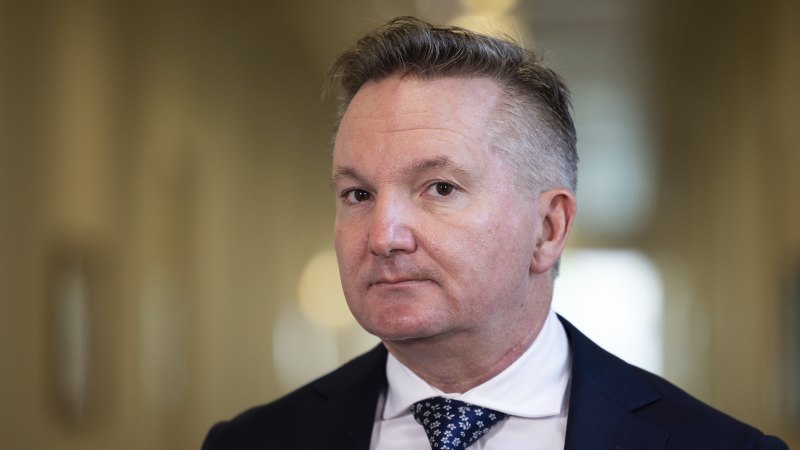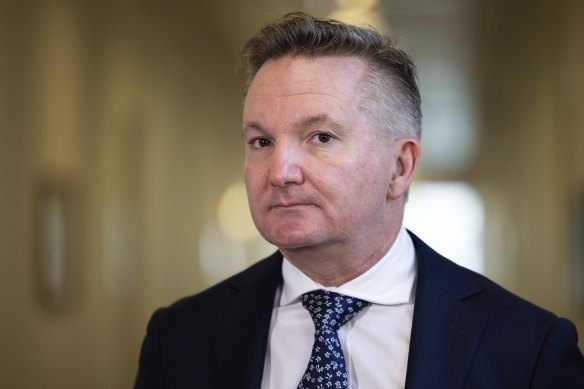
Hydrogen needs to hit the gas, fossil fuel lobby says
05/14/2023Save articles for later
Add articles to your saved list and come back to them any time.
Gas producers will argue the federal government is at risk of delaying commercialisation of the nascent clean hydrogen industry by excluding fossil fuels from its new $2 billion fund to kick-start the emerging industry.
The Albanese government says last week’s federal budget was designed to grow Australia into a renewable-energy superpower, unveiling the $2 billion Hydrogen Headstart program as the centrepiece of the package to subsidise private companies that invest in development of green hydrogen projects.
Climate Change and Energy Minister Chris Bowen.Credit: Alex Ellinghausen
Hydrogen burns cleanly and emits only water vapour, so many governments, including the United States and European Union, are backing it in with hundreds of billions of dollars of industry support as a potential boom fuel that could replace coal, gas and oil in heating, electricity generation, transport and a range of manufacturing processes.
The fuel can be produced with zero emissions using renewable energy to power electrolysers to split water into hydrogen and oxygen, with the end product known as “green hydrogen”. It can also be produced with energy generated by burning coal or gas – this is called “grey hydrogen” when the resulting emissions are released into the atmosphere and “blue hydrogen” when carbon capture and storage technology eliminates the emissions.
Neither blue nor green hydrogen is being produced on scale anywhere in the world, despite the hopes for growth, and US President Joe Biden’s funds are open to both. Australian Petroleum Production and Exploration Association chief executive Samantha McCulloch, whose members include Australia’s biggest gas producers, warns this means Australia will lag development in the US.
“They are looking at the fastest, cheapest way of scaling up a hydrogen economy. That’s what we will be competing with as a nation, and we would be encouraging the government to take an equally colour-agnostic approach,” she said.
Despite industry calls for government to expand its focus to blue hydrogen, Climate Change and Energy Minister Chris Bowen said international demand was overwhelmingly for green hydrogen.
“There’s huge demand for Australian green hydrogen; huge demand, most particularly, frankly, from Europe – Germany being at the right at the centre of the demand.”
But Bowen conceded that Australia was locked in a “global race for capital” and needed to build its green industries after the US and EU launched huge green funds to lure investors.
Biden unveiled a $550 billion industry stimulus scheme through his Inflation Reduction Act, offering funding to businesses and tax breaks for clean industries. In response, the EU in February committed $270 million to green industries, including tax breaks for businesses investing in clean technologies.
“We need to ensure we get the capital,” Bowen said. “This $2 billion is to keep us in the game to get that capital.”
The government will provide funds to companies via a credit that is payable only when production has commenced.
Australia’s leading hydrogen proponent, mining magnate Andrew “Twiggy” Forrest, has backed Bowen’s green push.
But McCulloch said Australia should pursue blue hydrogen to capitalise on its vast gas production capacity to help develop the nascent industry.
“In countries like Australia where you have good gas resources and good CO2 storage resources, [blue hydrogen] can be a more mature and lower-cost pathway to developing hydrogen,” she said.
“When you compare to what the Inflation Reduction Act is doing in the US, they are letting the market and investment environment determine how that hydrogen is brought to market. It’s allowing that innovation, bottom-up investment, to support the fastest cheapest pathway.”
The comments come as the oil and gas industry published a new report on Sunday night, suggesting nine “net zero zones” could be created across Australia – based around existing resources and manufacturing regions – to share infrastructure for gas, renewable energy, carbon capture and low-carbon hydrogen production.
The zones, which could be located in areas such as Adelaide-Port Augusta, Melbourne-Gippsland, Sydney-Newcastle, WA’s Pilbara and Queensland’s Surat Basin, could become “magnets” for regional investment and enable different industries to reduce costs and speed up their transitions to net zero emissions.
“Leveraging existing infrastructure can ensure regions that powered the Australian economy to where it is today won’t be left behind as we restructure our economy for the future,” McCulloch said.
Cut through the noise of federal politics with news, views and expert analysis from Jacqueline Maley. Subscribers can sign up to our weekly Inside Politics newsletter here.
Most Viewed in Politics
From our partners
Source: Read Full Article


